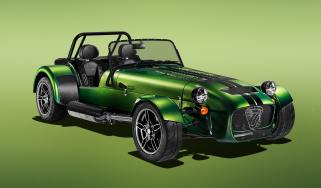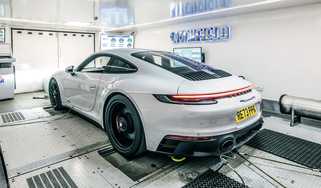Audi RS6 Performance – ride and handling
Performance upgrades have usefully sharpened up the RS6's chassis, masking some – if not all – of its 2090kg kerb weight
One of the great surprises of the current C8 RS6 is that it has both a very liveable ride quality when its Comfort damping mode is selected, and is agile and involving enough when you ask it to up its game.
Audi has worked very hard with its recent generation of S and RS models in areas that don’t just improve objective measures of performance, but also subjective ones. Stiffer bushings, better matching of suspension to wheel size and weight and the tyre’s performance, along with retuned mapping for the steering all came under scrutiny in the C8’s development and have continued to be evolved since its 2019 launch.
Fitment of rear-wheel steering has helped considerably when it comes to the RS6 Performance’s dynamics. It provides the car with an agility that was previously alien to the Audi when compared against its rivals, but that’s not the case now.
There are times that, despite being 5mm under five metres long, it feels more compact than its smaller non-Competition RS4 sibling, and it’s a difference amplified when you’re tackling a road normally better suited to smaller and agile cars. Now the RS6 Performance turns in positively, hangs on mid-corner and exits cleanly in a way no car this big or heavy has any right to.
More reviews
In-depth reviews
Long term tests
Reviews
Is it as involving as an M5 Competition? No, it lacks the detailed feedback and togetherness that it inherently engineered into the BMW M car. And it lacks the purity of an E63 and the polish of the outgoing Porsche Panamera Sport Turismo. But then you remember it’s a two-tonne estate car, and how it drives on its door-handles matters very little to those who buy this type of car. Where the RS6 triumphs is how it is now much, much closer to its rivals, dynamically feeling more hooked up and agile than previous generations of RS6.
Its steering isn’t what you would call chatty, but there’s a clarity to its response, progression and weighting that makes cornering an intuitive process rather than guesswork of old. Naturally the RS6 Performance can’t mask its mass and under braking and over crests you need to be mindful there’s a lot of weight to control.
Cars fitted with air springs have more float and less body control, even in their firmer modes, but still plenty of ability. If you’re really serious about cornering your two-tonne monster then you should tick the Dynamic Ride Control box, but for most the air set-up could be an ideal compromise for UK roads.
Where once the RS6 was fast but inert, the Performance is even faster, but also a car that responds faithfully enough that you now feel like a driver rather than an operator. It’s a subtle difference, but for people like us, an important one too.




